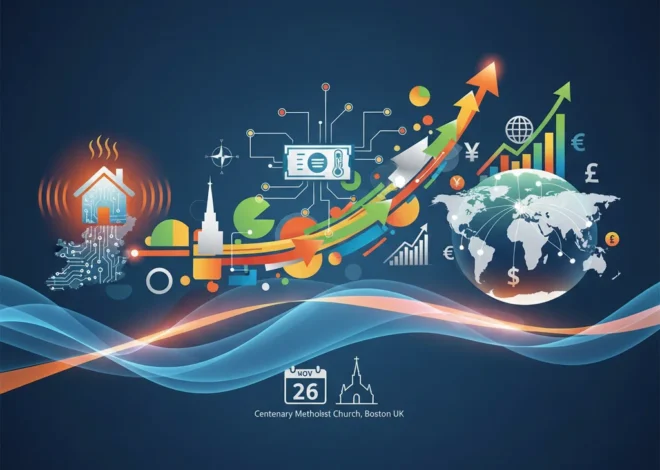
Beyond the Handshake: Decoding the Multi-Billion Dollar Economics of the US-Saudi Alliance
In the high-stakes world of international relations, a diplomatic visit is never just a visit. It’s a carefully orchestrated event where geopolitical posturing, strategic alliances, and colossal financial agreements converge. When Saudi Crown Prince Mohammed bin Salman (MBS) arrived in Washington, the conversations went far beyond pleasantries. On the table were deals poised to reshape regional security and, more importantly for investors and business leaders, redirect billions of dollars across the global economy. The signaling of support from the White House for the sale of advanced F-35 fighter jets was merely the headline for a much deeper story about finance, ambition, and the future of global energy markets.
This visit was not simply a transaction for military hardware; it was a powerful affirmation of a decades-old alliance entering a new, dynamic phase. For those in the world of investing and global economics, understanding the undercurrents of this partnership is crucial. The decisions made in these closed-door meetings have a direct and lasting impact on everything from defense contractor valuations on the stock market to the long-term trajectory of financial technology in the Middle East.
The Geopolitical Framework: Security as an Economic Cornerstone
At the heart of the discussions was the potential sale of Lockheed Martin’s F-35 Lightning II fighter jets, the world’s most advanced stealth combat aircraft. According to a report from the Financial Times, the Trump administration signaled its support for this landmark deal, a move with profound strategic implications. Historically, the U.S. has been cautious about providing such technology to Arab nations to maintain Israel’s Qualitative Military Edge (QME) in the region. A green light for the F-35s would represent a significant shift, cementing Saudi Arabia’s role as a top-tier U.S. security partner.
But why does this matter to someone focused on finance or trading? Because regional stability, or the lack thereof, is a primary driver of volatility in global markets. A strengthened Saudi military, from the U.S. perspective, acts as a powerful counterbalance to Iranian influence in the Middle East. This strategic calculation is designed to secure the free flow of oil through critical chokepoints like the Strait of Hormuz. Any disruption in this region immediately sends shockwaves through energy markets, affecting inflation, corporate earnings, and consumer spending worldwide. Therefore, a multi-billion dollar defense deal is, in essence, an insurance policy on economic stability, paid for by the Kingdom and underwritten by U.S. military technology.
The deal also highlights the intricate lobbying and diplomatic efforts at play. The original FT article noted that rival Gulf state Qatar had been actively lobbying against the deal (source), showcasing the competitive dynamics within the Gulf Cooperation Council (GCC). For international investors, these regional tensions are a critical risk factor to monitor, influencing everything from supply chain logistics to cross-border investment flows.
The Great Financial Crossword: Decoding the Puzzles of the Modern Economy
Vision 2030: The Economic Ambition Driving Foreign Policy
To view MBS’s visit solely through a military lens would be a profound miscalculation. The Crown Prince was also on a mission as the chief architect of Saudi Arabia’s Vision 2030, one of the most ambitious economic transformation plans in modern history. This blueprint is designed to wean the Kingdom off its “addiction” to oil, diversifying its economy into sectors like technology, tourism, entertainment, and logistics.
This is where the connection to the world of investing becomes crystal clear. Vision 2030 requires hundreds of billions of dollars in foreign investment and, just as importantly, foreign expertise. The visit to the U.S. was a “roadshow” to attract American capital and corporations. The deals being discussed extended far beyond defense to partnerships in infrastructure, technology, and entertainment.
The engine behind this global investment spree is the Public Investment Fund (PIF), Saudi Arabia’s sovereign wealth fund, which aims to become the largest in the world. The PIF has already made significant splashes in the U.S. market with multi-billion dollar stakes in companies like Uber, Lucid Motors, and Blackstone’s infrastructure fund. These moves are a clear example of “petrodollar recycling”—where oil revenues are reinvested into the U.S. economy, creating a symbiotic financial relationship. For investors, tracking the PIF’s strategy offers a glimpse into the future, as its capital allocations can create entire new industries and boost valuations in targeted sectors.
To grasp the scale of this transformation, consider the key investment areas under Vision 2030 that are actively seeking international partnership:
| Vision 2030 Pillar | Description & Key Projects | Investment Opportunity Areas |
|---|---|---|
| Technology & Innovation | Building a knowledge-based economy. Includes the futuristic mega-city NEOM, a $500 billion project focused on AI, robotics, and biotechnology. | AI development, Fintech, Blockchain for smart contracts, IoT infrastructure, Venture Capital. |
| Tourism & Entertainment | Developing luxury resorts on the Red Sea, theme parks like Qiddiya, and hosting international sporting and music events to attract 100 million annual visitors. | Hospitality management, entertainment production, luxury retail, travel technology, F&B franchises. |
| Financial Services | Modernizing the Saudi stock market (Tadawul) and opening it to foreign investors. Fostering a vibrant financial technology sector. | Asset management, investment banking, digital payment platforms, robo-advisory services. |
| Industrial & Energy Diversification | Moving beyond crude oil extraction into refining, petrochemicals, and becoming a world leader in solar and green hydrogen production. | Renewable energy technology, project finance, logistics and supply chain management, advanced manufacturing. |
The Corporate Handshake: How Swiss Business Leaders Brokered a Landmark US Tariff Reduction
The Market Impact: From Defense Stocks to Digital Banking
The immediate and most direct impact of the announced deals is on the stock market. A potential multi-billion dollar order for F-35s is a significant tailwind for Lockheed Martin (LMT) and its extensive supply chain, which includes hundreds of companies across the U.S. News of such deals often leads to a rally in defense sector stocks, a clear cause-and-effect for those involved in trading.
However, the ripple effects extend far beyond the defense industry. The broader commitment to Vision 2030 signals a massive opportunity for American companies in nearly every sector. As Saudi Arabia builds new cities and industries from the ground up, it needs cutting-edge financial technology to power its new economy. This opens a vast market for U.S. fintech firms specializing in digital payments, online lending, and wealth management. The modernization of the Saudi banking sector is a top priority, creating demand for everything from core banking software to blockchain solutions for trade finance and supply chain integrity.
This digital transformation is not a “nice-to-have”; it is essential for achieving the goals of Vision 2030. A diversified, non-oil economy cannot run on an outdated financial infrastructure. It requires a seamless, secure, and technologically advanced ecosystem to attract foreign capital and foster domestic entrepreneurship. This necessity creates a greenfield opportunity for established financial players and nimble fintech startups alike, making the Kingdom one of the most fascinating growth stories in global finance today.
The successful execution of these large-scale projects, backed by American technology and capital, also has a stabilizing effect on the long-term outlook for the Saudi economy. A more diversified and robust Saudi Arabia is less susceptible to shocks in oil prices, which in turn contributes to a more predictable global economic environment—a benefit for all long-term investors. A recent analysis pointed out that the total value of deals discussed could run into tens of billions of dollars (source), a significant injection of capital and commerce.
Echoes of '97: Is Labour Repeating Blair's Greatest Economic Gamble?
Conclusion: A Symbiotic Relationship for a New Economic Era
The visit of Crown Prince Mohammed bin Salman to Washington was a powerful illustration of how 21st-century diplomacy is inextricably linked with global economics and finance. The F-35 deal, while significant, was just one piece of a much larger puzzle. The real story is the deepening of a symbiotic relationship where U.S. security and technology underwrite Saudi Arabia’s ambitious economic transformation, and in return, Saudi capital and market opportunities fuel growth in the U.S. economy.
For investors, finance professionals, and business leaders, the takeaway is clear: the U.S.-Saudi alliance is a critical axis in the global financial system. Understanding its nuances—from the strategic importance of defense sales to the vast opportunities within Vision 2030—is no longer optional. It is essential for navigating the complexities of the modern global market, identifying emerging opportunities, and managing the inherent risks of a world in constant flux.


